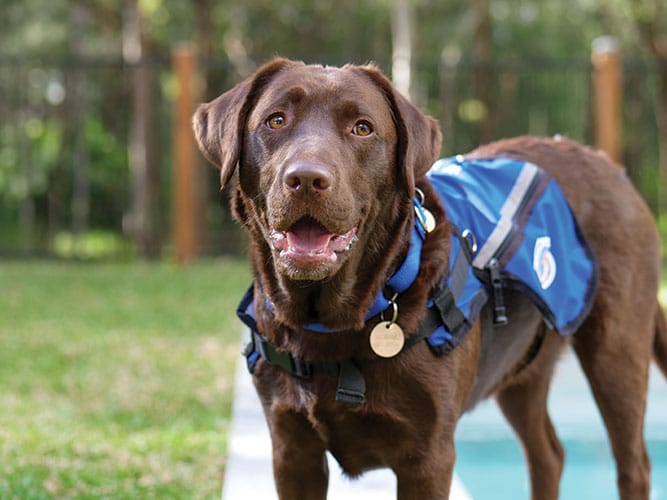A dog at school? Really?! Yes, in recent years the Educational Support Dog has made its (paw) mark. They’re more than just furry companions – these four-legged heroes are adept at reducing stress and anxiety in pupils, enhancing children’s social skills, boosting their self-esteem, and fostering a sense of belonging among students.
In this blog post, we’ll explore the myriad benefits of integrating support dogs into educational environments and how these canine companions are used in schools.
In this article

What’s an Educational Support Dog?
Simply put, Educational Support Dogs are dogs that are trained to help students in schools. They’re specially trained to aid in children’s learning and emotional needs, and are different from other Assistance Dogs in a few key ways:
Focus on education
They’re primarily trained to assist students in a learning environment. They can help them concentrate, reduce stress, and improve their overall emotional well-being while at school.
Emotional support
While other Assistance Dogs, like service dogs, help people with physical disabilities by performing specific tasks, Educational Support Dogs focus on providing emotional support. They can help students with invisible disabilities, including managing anxiety, calming them down during stressful situations, and boosting their self-esteem.
Training they receive
Educational Support Dogs receive specific training to work in schools. They learn to remain stable, dependable and alert in a busy classroom, interact well with children, and respond to the unique needs of students in an educational setting.
Their in-school activities
These dogs engage in activities that promote a positive learning environment. They may take part in reading programs where students read aloud to them, provide comfort during tests, or simply be a friendly presence in the classroom.
For more on different types of assistance dogs, check out What is an Assistance Dog and How Do They Support Disability?
Check out this pup in action:
How does a dog at school help children?
Research has shown that having these special dogs in schools can have a number of positive benefits for students, as mentioned above. Assistance Dogs Australia reports: “Leading cognitive engagement activities with the aid of an accredited Assistance Dog can result in far-reaching improvements in student literacy development.”
Let’s delve deeper now into how these wonderful dogs help:
#1 A dog at school reduces stress and anxiety
The presence of therapy dogs in schools offers a soothing balm to the stresses and anxieties that often accompany the educational journey. Studies have shown that spending time with dogs can trigger the release of oxytocin, a hormone that promotes feelings of trust and bonding.
This, in turn, helps to alleviate stress levels and reduce apprehension, fearfulness and other emotions among students that are unfavourable to learning.
Simply petting a dog can create an immediate sense of calm, providing a valuable tool for emotional regulation. For example, children who have PTSD or similar due to trauma can benefit from the calming effects of a dog.
#2 A dog at school improves social skills
Educational Support Dogs function as social catalysts, breaking down barriers and fostering interactions among students. Through structured activities and unstructured play, children learn important social skills such as empathy, communication, and cooperation.
The non-judgmental nature of dogs creates a safe space for kids to practice these skills, building confidence and paving the way for healthier relationships both within and outside the classroom.
Educational Support Dogs can be particularly beneficial to kids with autism, who may feel lonely or isolated. Read more here – Assistance Dogs and Autism: How Can a Dog Help?

#3 A dog at school increases self-esteem
The unconditional love and acceptance offered by a dog at school can be a transformative force in a student’s life. Interactions with these gentle creatures provide a boost to self-esteem, instilling a sense of worthiness and belonging.
For children struggling with self-confidence, the presence of a support dog can be a powerful motivator, encouraging them to take risks and engage more fully in their learning experiences.
#4 A dog at school promotes a sense of belonging
In a world where the feeling of belonging is paramount to mental well-being, support dogs play a vital role. They create a welcoming and inclusive atmosphere within the school, ensuring every student feels valued and appreciated.
The bond forged between a child and support dog serves as a constant reminder that they’re an integral part of the school community.
How is an Educational Support Dog trained?
According to Assistance Dogs Australia (ADA), the cost of training an accredited Assistance Dog is $40,000. Check out What Does it Take to Train an Assistance Dog? for more on this. The organisation does this entirely through generous donations from the public, philanthropic activities and grants:
“We carefully select our dogs based on their health and temperament. From eight weeks of age, our expert staff invest hundreds of hours training each puppy over a two year period, transforming them into qualified Assistance Dogs.
After an initial 12 months of puppy development and training, our dogs undertake advanced training where they master up to 50 specialised cues that teachers use to help regulate their class.”
-ADA
Once an Educational Support Dog is trained, ADA carefully matches them with schools on their waiting list. Their trainers help the school’s chosen caregivers right away. They also give a 5-day training course to teach caregivers how to handle a dog at school in a classroom.
Read more in our What Does it Take to Train an Assistance Dog? article.
How do I get an Educational Support Dog?
At the time of writing, due to the overwhelming demand Assistance Dogs Australia has temporarily closed applications for Educational Support Dogs. However, you can get in touch with them to find out whether a dog may be available in future.
Want to find out about more amazing pups who are making the lives of those living with disability easier? Check out these articles:
- Vietnam Veteran’s PTSD Dog Makes Life Better: Here’s How
- Inspiring Assistance Dogs You’ll Want to Know
- Pups in Prison: Assistance Dogs & Prisoners
- What Do Assistance Dog Puppy Volunteers Do?
Value-rich insurance for your pet
As Australia’s first disability and independence insurance specialist, Blue Badge Insurance understands the needs of those living with disability. Those with an Assistance Dog can get 25% off our Assistance Dogs insurance. If you have a therapy animal or pet your disability parking permit can also get you 15% discounted pet insurance, not to mention up to 25% off disability car insurance for wheelchair accessible vehicles and converted cars.
Or, perhaps you’d like a quick wheelchair insurance or mobility scooter insurance quote?
Click below now.








